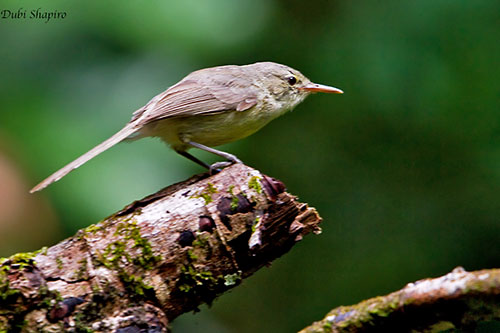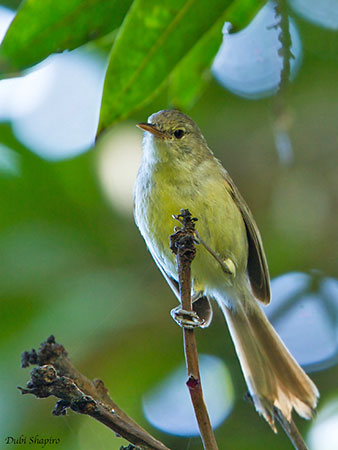
REPRODUCTION OF THIS SPECIES:
The breeding season occurs from late September to March.
The Rodrigues Warbler is territorial. The nest is a deep cup built between 0,5 and 9 metres above the ground, in fork of two or more slender branches in tree such as Strawberry guava, Rose-apple or Tecoma.
The nest-shape may vary from tall, inverted cone to more or less flat-bottomed structure. The cup is made of woven grass and lined with some feathers.
The female lays 2-3 eggs, and both adults incubate during at least 10-11 days. One or two chicks are reared and fledge about two weeks after hatching. This species may produce two broods per season.
PROTECTION / THREATS / STATUS:
The Rodrigues Warbler was once probably widespread on Rodrigues, but during the mid-20th century, its range contracted dramatically due to loss and fragmentation of the habitat, severe droughts and cyclones.
In 1999, the population was estimated less than 150 individuals, and this level remained until 2004. Thanks to habitat protection and reforestation, the population was estimated at 3,100/3,900 individuals by 2010, and close to 4,000 by 2012.
The population is now estimated at 3,000/4,000 individuals, equating to 2,000/2,700 mature individuals.
This population is still increasing but the species has restricted range and remains vulnerable to stochastic events and introduced species.
The Rodrigues Warbler is currently listed as Near Threatened.
Fr: Rousserolle de Rodrigues
Ang: Rodrigues Warbler
All: Rodriguezrohrsänger
Esp: Carricero de Rodrigues
Ita: Cannaiola di Rodriguez
Nd: Rodriguesrietzanger
Sd: rodriguessångare
Photographer:
Dubi Shapiro
Dubi Shapiro Photo Galleries & Dubi Shapiro's Pictures on IBC
Text by Nicole Bouglouan
Sources:
HANDBOOK OF THE BIRDS OF THE WORLD Vol 11 by Josep del Hoyo, Andrew Elliott and David Christie - Lynx Edicions - ISBN: 849655306X
L’ENCYCLOPEDIE MONDIALE DES OISEAUX - Dr Christopher M. Perrins - BORDAS - ISBN: 2040185607
OISEAUX des ÎLES DE L’OCÉAN INDIEN De Ian Sinclair – Editeur : Penguin Random House South Africa, 2013 – ISBN : 1775840727, 9781775840725 - 263 pages
Reed and Bush Warblers Par Peter Kennerley, David Pearson – Helm Identification Guide – Editeur: A&C Black, 2010 – ISBN: 1408134012, 9781408134016
African Bird Club - Extension of breeding activity for Rodrigues Warbler Acrocephalus rodericanus
Population census and habitat use of Rodrigues Warbler Acrocephalus rodericanus
Rodrigues Warbler
Acrocephalus rodericanus
Passeriformes Order – Acrocephalidae Family
INTRODUCTION:
The Rodrigues Warbler is resident and endemic to Rodrigues, an island of Mauritius. It frequents woodlands with non-native trees and shrubs, and dense vegetation close to clearings and forest edge. It feeds primarily on insects caught by gleaning. This species is territorial during the breeding season.
The Rodrigues Warbler is threatened by habitat loss, predation by cats and rats, cyclones and drought, and degradation of remaining suitable habitat. However, following a period of stable numbers between 1999 and 2004, the species has now increased its population by 2010, but the Rodrigues Warbler is currently listed as Near Threatened.
DESCRIPTION OF THE BIRD:
Biometrics:
Length: 13-14 cm
Weight: 11-13 g
The Rodrigues Warbler is a medium-sized warbler. Crown and upperparts are olive-brown whereas underparts are pale yellowish in fresh plumage and mostly greyish-white with yellow wash in worn plumage. The tail is long and graduated. The wings are short and rounded, with a large first primary.
On the head, the crown is olive-brown. We can see a pale yellowish supercilium and a short, blackish eyestripe. The cheeks are pale olive-brown and the lores are pale yellow.
The long, thin bill is pinkish to flesh-coloured with blackish culmen. The eyes are dark reddish-brown. Long legs and feet are blue-grey with yellowish soles.
Male and female are similar.
The juvenile has throat and breast variably yellow. The belly is whitish.
RANGE:
The Rodrigues Warbler is resident and sedentary on Rodrigues.

HABITAT:
The Rodrigues Warbler frequents scrubs and woodlands, but it is restricted to the central uplands where its distribution is fragmented. It is found in dense thickets and woodlands with non-native trees and shrubs. It usually favours the dense vegetation with an access to more open areas such as clearings and forest edge.
CALLS AND SONGS: SOUNDS BY XENO-CANTO
The Rodrigues Warbler gives sharp, sparrow-like calls described as « chipipi » or « chitik”.
The song is short and lasts only 1-2 seconds. The bird repeats a low, musical phrase, preceded of followed by one or two conversational notes. The sound may vary from one song to another, from rapid to harsher or strongly disyllabic, reminiscent of a Great Tit.
BEHAVIOUR IN THE WILD:
The Rodrigues Warbler feeds primarily on insects caught by gleaning in canopy or subcanopy. The diet includes homopteran bugs, and also lepidopteran adults and larvae.
The bird often cocks the tail up and down or flicks it from side to side. It is a very agile and active species, always moving while foraging by gleaning from leaves and twigs.
The Rodrigues Warbler is apparently monogamous, but occasional co-operative breeding is probable, although the territory is usually occupied by two birds. The species sings from anywhere within the territory and does not have usual perches.
The Rodrigues Warbler is resident on Rodrigues. It does not fly over long distances, because its long tail and the short, rounded wings make the flight low and laboured.
